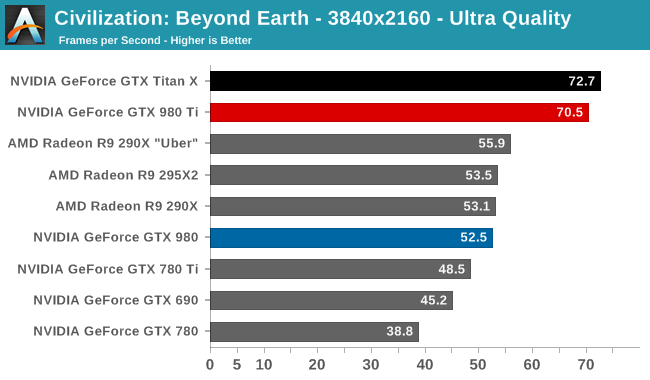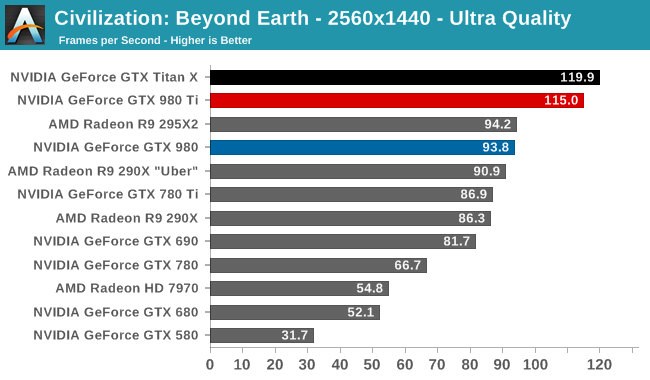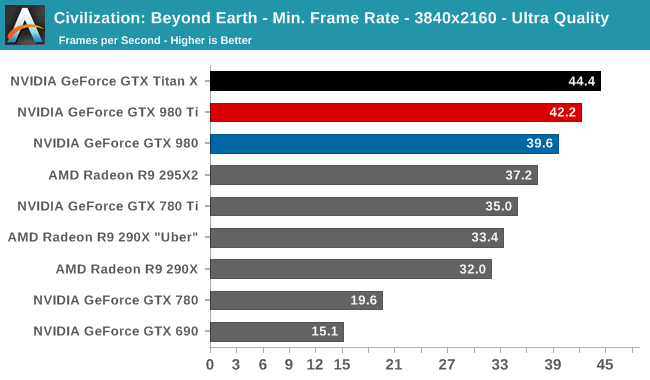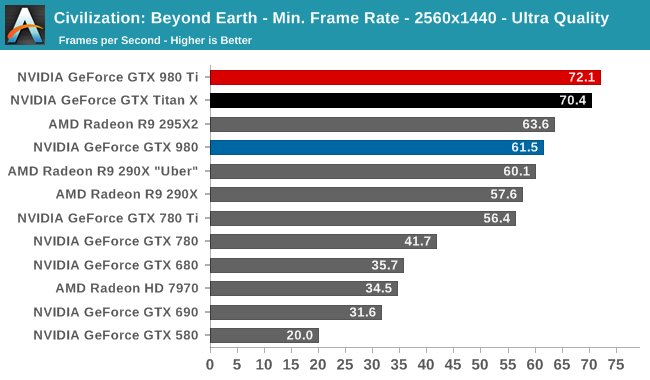The NVIDIA GeForce GTX 980 Ti Review
by Ryan Smith on May 31, 2015 6:00 PM ESTCivilization: Beyond Earth
Shifting gears from action to strategy, we have Civilization: Beyond Earth, the latest in the Civilization series of strategy games. Civilization is not quite as GPU-demanding as some of our action games, but at Ultra quality it can still pose a challenge for even high-end video cards. Meanwhile as the first Mantle-enabled strategy title Civilization gives us an interesting look into low-level API performance on larger scale games, along with a look at developer Firaxis’s interesting use of split frame rendering with Mantle to reduce latency rather than improving framerates.


Stop me if you’ve heard this one before: the GTX 980 Ti and GTX Titan perform within a few percent of each other. Under Civilization the gap between the two is a hair larger than in other games, at 3-4%, but this is also as large of a gap as you’ll see for average framerates. Even here the two are for all meaningful purposes tied.
Meanwhile on an absolute basis, the GM200 twin remain the only single-GPU cards to crack 60fps, with GTX 980 Ti delivering 70.5fps at the game’s most extreme setting. This is once again well ahead of the GTX 980 – beating it by 34% at 4K, though by less at lower resolutions where we start to get CPU-bottlenecked.
I also want to quickly touch upon how the GTX 980 Ti compares to the last-generation high-end GK110 Kepler cards, the GTX 780 and GTX 780 Ti. Against GTX 780 in particular, in this test we see the GTX 980 Ti deliver 70-80% better performance. With this being the 2 year anniversary of the GTX 780’s release, this is especially notable since it’s such a good example of how performance has improved specifically at this $649 price point in the last 2 years. GM200 in general is not this fast versus GK110 – there’s only so much to be done at 28nm – but against GTX 780 in particular NVIDIA’s latest card looks quite good. Even GTX 780 Ti is not entirely immune, with GTX 980 Ti beating it by around 45% at 4K.


When it comes to minimum framerates the same story continues; the two GM200 cards are very close to each other, staying within 5%. At worst, you can say that the 7-17% performance advantage over the GTX 980 isn’t very impressive, though this is admittedly a game that’s not too far off from being CPU-bottlenecked.










290 Comments
View All Comments
FlushedBubblyJock - Wednesday, June 10, 2015 - link
I bought a bunch of G80 G92 G92b and G94 nvidia cards because you could purchase memory size, bandwidth, bit width, power connector config, essentially any speed at any price point for a gamers rig, install the same driver, change the cards easily, upgrade for your customers without hassles...IT WAS A GOLD MINE OF FLEXIBILITY
What happened was, the amd fanboys got very angry over the IMMENSE SUCCESS of the initial G80 and it's reworked cores and totally fluid memory, card size, bit width, and pricing configurations... so they HAD TO TRY TO BRING IT DOWN...
Thus AMD launched their PR war, and the clueless amd fan launched their endless lies.
I'll tell you this much, no on would trade me a 9800GTX for a 9800GT
I couldn't get the 92 bit width cards for the same price as the 128 bit
DDR2 and DDR3 also differentiated the stack massively.
What we had wasn't rebranding, but an amazingly flexible GPU core that stood roaring above at the top and could be CUT down to the middle and the low gaming end, an configured successfully with loads of different bit widths and memory configs....
64 bit width, 92, 128, 256, 384, 192, ETC...
That was an is a awesome core, period.
BillyONeal - Sunday, May 31, 2015 - link
And people have been bent out of shape about it. For "YEARS" :)dragonsqrrl - Sunday, May 31, 2015 - link
Their highest-end rebadge, the 390X, will likely compete with the 980, not the 980 Ti. The 980 Ti will be closer to Fiji's performance profile.austinsguitar - Sunday, May 31, 2015 - link
I dont think you realize how much more efficiant this card is even compared to past cards for its nm and performance. This is a feat. Just calm down and enjoy. I am very happy that the cards price us perfect. :) thanks nvidiaMapRef41N93W - Sunday, May 31, 2015 - link
Maybe you aren't aware of how silicon works, but this a 601mm^2 die which costs a boat load to produce especially with the rising costs of crystalline silicon dies. Being on 28nm this long just means the yields are higher (which is why a 601mm^2 is even possible).You aren't going to see a 14nm card that outperforms this by much till 2017 at the earliest which following the recent NVIDIA trends should see the Titan XYZ (whatever they want to call it) which should be a pretty huge jump at a pretty high price.
Thomas_K - Monday, June 1, 2015 - link
Actually AMD is doing 14nm starting next yearhttp://www.guru3d.com/news-story/it-is-official-am...
"Although this was a rumor for a long time now we now know that AMD skips 20nm and jumps onto a 14nm fabrication node for their 2016 GPUs."
dragonsqrrl - Sunday, May 31, 2015 - link
Not sure I understand your comment, 28nm is precisely why we're paying this much for this level of performance in 2015... But it's also pretty impressive for the same reason.Azix - Sunday, May 31, 2015 - link
14/16nm might cost more. 28nm should have better yields and lower cost. These chips do not cost much to make at all (retail price could be 2-3 times the chip cost)dragonsqrrl - Sunday, May 31, 2015 - link
I think you misinterpreted my comment. I was responding to someone who seemed shocked by the fact that price/performance ratios aren't improving dramatically despite the fact that we're on a very mature process. In response I said the fact that we're on the same process is precisely why we aren't seeing dramatic improvements in price/performance ratios."28nm should have better yields and lower cost. These chips do not cost much to make at all (retail price could be 2-3 times the chip cost)"
Yields are just one part of the equation. Die size also plays a significant role in manufacturing costs. The fact that your trying to say with a straight face that GM200 does not cost much to make says more than your written comment itself.
zepi - Monday, June 1, 2015 - link
Assuming perfect scaling 600mm2 28nm chip would shrink to 150mm2 at 14nm.GM107 is a 148mm2 chip, so basically this "monster" with just a dieshrink would find a nice place for itself at the bottom end of Nvidias lineup with after transition to 14nm.
This does not take into account the fact that at 14nm and 150mm2 they couldn't give it enough memory bandwidth so easily, but just tells you something about how significant the reduction in size and manifacturing cost is after the initial ramp-up of the yields.